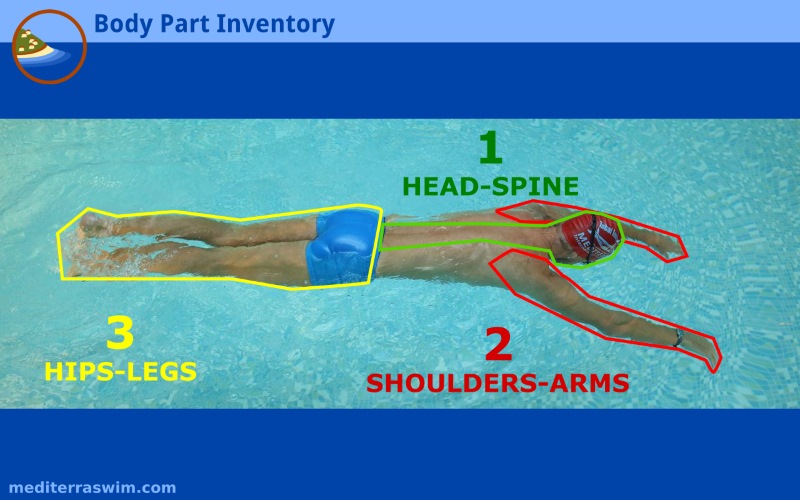Forums › Personal Discussion Zone › PDZ Users N through Z › Russell.sc Discussion Forum › 2021 07 Private Lessons Russell.sc
Please type your comments directly in the reply box - DO NOT copy/paste text from somewhere else into the reply boxes - this will also copy the code behind your copied text and publish that with your reply, making it impossible to read. Our apology for the inconvenience, but we don't see a convenient way of fixing this yet.
-
AuthorPosts
-
July 30, 2021 at 16:47 #32078
Jamee Small
Keymaster21/07/26
It was a pleasure meeting and working with you today. Well done! We’re on our way to building a firm foundation for an effective and efficient stroke.
In our first lesson we explored the initial building blocks for aquatic activities, Air Management and Balance. Each activity we do will aim to…
- Build dialogue between you and your holistic body
- Relax the Mind and Body
- Shape Body Structure
- Incorporate Air Management Skills
As we progress your list of passive and active details and skills will grow. To best incorporate these skills and not overwhelm the system, we use drills and focal points. I will ask you to hold one focal point at a time until it becomes more familiar and comfortable. Eventually it will become easier to hold and balance two, eventually three at the same time, and so on. In the meantime, you may like to organize your body into sections.
- Head and Spine
- Shoulders and Arms
- Hops and Legs

For example – You can use this organization while working through drills and focal points by first consider learning to hear your Head and Neck and what it’s doing, where is it and how to does it feel; then relax it fully; followed by noting the ideal shape and structure you want to hold it in for that activity; then incorporate the air management.
There is a lot of feedback in the pool environment. It can easily distract and even overwhelm the nervous system from the activities at hand. To help isolate and alleviate some of the pressures, you may consider using Support Structures as outlined in How to Use Support Structures until you feel more confident with the skills and activities.
Air Management
You breath all day, every day until your last day. Most the time you have easy access to air and use it without thinking. When you are in the water, your air management can be the first thing that incites discomfort. Understanding what it actually feels like to have no air, all the air, build up of CO2, switching between the forms can help you better adjust to the various sensation you experience throughout activities.
You can exhale via the mouth or nose. I recommend using a nasal exhale. It allows you more control and protects against water running up. During all other drills and activities, you will interchangeably hold your breath and exhale, incorporating both sensations.
Breathing Drills
- Diaphragmatic Breathing (Dryland)
- Holding Breath
- Exhale (via mouth)
- Exhale (via nose)
- Extended Breath Hold
- Extended Breath (With mouth open)
- Submerged Exhale
Breathing Foal Points
- While focusing on air management, pay attention to the body’s feedback. Take note of any tension and where, feeling of decreased lung capacity, stability, hold on supports, reaction times, etc. When something comes ups, try to sit with the sensation instead of fighting, controlling or reacting to it. Just listen
You can also practice in the comfort of your own home with breathing exercises.
Building the Frame
For further course notes, we will be referring to the Freestyle Fundamentals Course. Balance Position Introduction, Lesson and Practice Set are found in Lesson 1 Build the Frame.
If you’d like a smooth transition from front float to standing, see Front Float Recovery.
Please take advantage of this discussion zone to ask me specific questions about what and how to practice. This space is meant to support you in your personal training time.
August 4, 2021 at 18:28 #32083Jamee Small
Keymaster21/08/03
Today’s lesson we began to build the Streamline Shape, the frame on which we will transfer force and glide forward. You may view the lesson notes and practice set suggestion in the Freestyle Fundamentals course notes.
Also, we discussed the Interrupted Breathing position. This self-rescue breathing position is quite handy in allowing you to continue moving through the water, without disturbing the balanced, neutral position of the frame. It also begins to rehearse key foundations that will later be present in the Integrated, or Rhythmic Breath.
August 17, 2021 at 15:33 #32095Jamee Small
Keymaster21/08/17
Great work today! You’ll be able to progress through the Freestyle Fundamentals course into the Generating Forward Momentum lesson on the Recovery Swing.
Let me know if you have any questions during you practice in the next few weeks.
-
AuthorPosts
- You must be logged in to reply to this topic.
